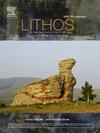Multi-stage continental crust maturation in accreted oceanic terranes: Evidences from granitoids in the Qinling Orogen, Central China
IF 2.9
2区 地球科学
Q2 GEOCHEMISTRY & GEOPHYSICS
引用次数: 0
Abstract
Accreted oceanic arc terranes are crucial sites for net continental crust growth. It is intriguing how the mafic oceanic arcs can subsequently evolve into high-Si and K-rich mature continental crust. The granitoid Xizhuanghe and Dongzijie plutons display enriched geochemical composition and occur in the same oceanic arc unit of the Paleozoic Qinling orogen. They provide an ideal opportunity to reveal the mechanism for transforming mafic oceanic arcs to continental crust. The Xizhuanghe and Dongzijie granites have zircon U![]() Pb ages of ca. 460 Ma and 454 Ma, respectively, after the collision between the Erlangping and North Qinling units. Geochemically, both of them display low Mg# (38.9–45.4 vs. 18.9–43.4) values and arc-type trace element distribution patterns. According to the different K2O/Na2O ratios, the Xizhuanghe pluton is relatively sodic I-type granites, while the Dongzijie pluton belongs to typical potassic species. They are characterized by depleted Sr-Nd-Hf compositions (Xizhuanghe: 87Sr/86Sri = 0.704171–0.704692, εNd(t) = +1.68 ∼ +2.23, zircon εHf(t) = +5.9 ∼ +9.8; Dongzijie: 87Sr/86Sri = 0.694356–0.705627, εNd(t) = −0.94 ∼ +1.37, zircon εHf(t) = +8.1 ∼ +11.9) and zircon δ18O values (Xizhuanghe: 4.31–5.15 ‰; Dongzijie: 3.30–5.19 ‰) lower than those of normal mantle zircon, indicating that the mafic precursors of the two plutons might be the Erlangping lower oceanic crust, which might be heterogeneously modified in a supra-subduction zone and have experienced high-temperature hydrothermally alteration with seawater. We suggest that the Xizhuanghe pluton can directly be produced by partial melting of such mafic oceanic crust, while the Dongzijie pluton needs additional fractionation process: dehydration melting of sodic felsic rocks generated by partial melting of the enriched lower oceanic crust. Our finding highlights the significance of the enriched oceanic crust and multi-stage differentiation within oceanic arc crust plays an important role for progressively crust maturation in accretionary orogens.
Pb ages of ca. 460 Ma and 454 Ma, respectively, after the collision between the Erlangping and North Qinling units. Geochemically, both of them display low Mg# (38.9–45.4 vs. 18.9–43.4) values and arc-type trace element distribution patterns. According to the different K2O/Na2O ratios, the Xizhuanghe pluton is relatively sodic I-type granites, while the Dongzijie pluton belongs to typical potassic species. They are characterized by depleted Sr-Nd-Hf compositions (Xizhuanghe: 87Sr/86Sri = 0.704171–0.704692, εNd(t) = +1.68 ∼ +2.23, zircon εHf(t) = +5.9 ∼ +9.8; Dongzijie: 87Sr/86Sri = 0.694356–0.705627, εNd(t) = −0.94 ∼ +1.37, zircon εHf(t) = +8.1 ∼ +11.9) and zircon δ18O values (Xizhuanghe: 4.31–5.15 ‰; Dongzijie: 3.30–5.19 ‰) lower than those of normal mantle zircon, indicating that the mafic precursors of the two plutons might be the Erlangping lower oceanic crust, which might be heterogeneously modified in a supra-subduction zone and have experienced high-temperature hydrothermally alteration with seawater. We suggest that the Xizhuanghe pluton can directly be produced by partial melting of such mafic oceanic crust, while the Dongzijie pluton needs additional fractionation process: dehydration melting of sodic felsic rocks generated by partial melting of the enriched lower oceanic crust. Our finding highlights the significance of the enriched oceanic crust and multi-stage differentiation within oceanic arc crust plays an important role for progressively crust maturation in accretionary orogens.
求助全文
约1分钟内获得全文
求助全文
来源期刊

Lithos
地学-地球化学与地球物理
CiteScore
6.80
自引率
11.40%
发文量
286
审稿时长
3.5 months
期刊介绍:
Lithos publishes original research papers on the petrology, geochemistry and petrogenesis of igneous and metamorphic rocks. Papers on mineralogy/mineral physics related to petrology and petrogenetic problems are also welcomed.
 求助内容:
求助内容: 应助结果提醒方式:
应助结果提醒方式:


